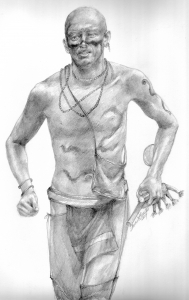
Skull Place

 The upper Ohio Valley was home to American Indian peoples for over 16,000 years. Archaeological evidence suggests that there were multiple use and occupation sites in the Wheeling area over several millennia. When European explorers and settlers made their way into the region in the eighteenth century, they encountered the Shawnee, Wyandot, Delaware (Lenape) and Mingo (pictured) peoples. Indeed, “Wheeling” is derived from “wee-lunk” in the Lenape language, meaning “head place” or “skull place,” a reference to a human skull that was placed on a pole near the mouth of Wheeling Creek as a deterrent to encroachment.
The upper Ohio Valley was home to American Indian peoples for over 16,000 years. Archaeological evidence suggests that there were multiple use and occupation sites in the Wheeling area over several millennia. When European explorers and settlers made their way into the region in the eighteenth century, they encountered the Shawnee, Wyandot, Delaware (Lenape) and Mingo (pictured) peoples. Indeed, “Wheeling” is derived from “wee-lunk” in the Lenape language, meaning “head place” or “skull place,” a reference to a human skull that was placed on a pole near the mouth of Wheeling Creek as a deterrent to encroachment.
These tribes considered the area their homeland, and when confronted with the expansion efforts of westward pushing colonists, they vigorously defended their territory, seeking to make the Ohio River the final barrier between Indian and European. As animosities intensified during the period of the American Revolution, the tribes of the region joined forces with the British and attacked the Wheeling settlements, laying siege to Fort Henry on two occasions. After 1794, however, regional American Indians relocated further west and the days of border warfare concluded. (Travis Henline from Legenday Locals of Wheeling, image by Anne Foreman)
Places of Wheeling Home | Wheeling History Home | OCPL Home








